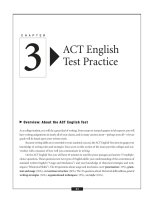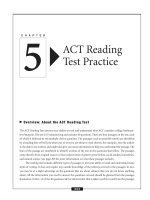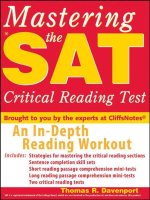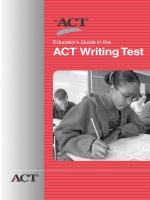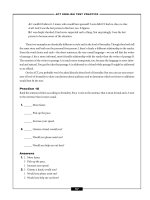ACT reading test preparation1
Bạn đang xem bản rút gọn của tài liệu. Xem và tải ngay bản đầy đủ của tài liệu tại đây (439.34 KB, 33 trang )
ACT Reading Test Preparation
Dakota State University
February 25, 2008
Deana Hueners-Nelson
Overview of the Session
•
•
•
•
Understanding the ACT Reading Test
Types of reading passages
Types of questions
General test-taking strategies for the reading
section
• Sample test passages
• Tips for preparing for the test
Understanding the Reading Test
• A total of 40 questions in 35 minutes
• 4 passages, each with 10 questions
• Scoring
– 1 test score for Reading
– 2 subscores for Literature/Humanities reading
skills and Social Sciences/Sciences reading skills
Types of Passages
• The following types of passages, each with 10
questions, are presented in this order:
•
•
•
•
Prose Fiction
Social Sciences
Humanities
Natural Sciences
• Some types of questions will show up
in every type of passage. Others
will be unique to specific types.
General Information about Passages
• Each passage is about 750 words
• Each passage is placed into two columns with line
numbers in the margin
• Each passage uses the same instructions.
Instructions never change. Therefore, save time
by reading and understanding the instructions
before taking the exam.
Prose Fiction Passages
• Prose fiction is the only fiction on the test
• Consists of excerpts from novels or short stories.
• Passages usually have a plot (a sequence of actions) and
characters
– Keep track of the actions – Who does what? Where was it done?
When was it done? Why was it done?
– Keep track of characters – What kinds of conflict do they face?
Conflict with another character?
Internal (conflict within him/herself?)
External (Man vs. Nature)? How does the
character change?
– Keep track of tone – Who is telling the story? Are
they biased? Objective? Be alert for connotative words.
Social Science Passages
• Expository writing that may focus on a variety of subjects,
including anthropology, biography, business, education,
geography, history, political science, and psychology. Passages
focus on analysis.
• Common organizational patterns include cause/effect,
chronological, and comparisons, so anticipate these types of
questions
– Keep track of organizational patterns – Is something being
compared? Is information offered in time
sequence? Are the causes of something
being discussed? Note these patterns.
– Note the main idea – If possible underline it.
Humanities Passages
• Excerpts from memoirs, personal essays, and non-fiction
prose in the areas of art, music, philosophy, television, and
theater.
• Passages are expository or descriptive and often focused on
appreciation of the arts.
– Note the main idea. If possible, underline it.
– Note the supporting details. Mark the booklet.
– Look for cause/effect relationships. Why is
something happening? Who or what is
responsible?
Natural Science Passages
• Scientific writings that focus on concepts, details,
generalizations, and theories.
• Contain many details, and these details need to be
related to larger ideas.
• Uses organizational patterns: enumeration,
classification, compare/contrast, sequence.
– Recognize the organizational pattern. Note
the main idea and the supporting
details.
Types of Questions
Questions will ask you to use referring and reasoning
skills to:
• determine main ideas
• locate and interpret significant details
• understand sequences of events
• analyze the author's or narrator's voice and method
• make comparisons
• determine the meaning of context-dependent words,
phrases, and statements
• comprehend cause-effect relationships
• draw generalizations
The ACT.
/>
Strategies for the Reading Test
• Balance your time
– 35 minutes for 4 passages – that’s less than 9 minutes per
passage. Don’t spend too much time on any one passage
or any one question.
• Know your strengths and weaknesses
– Use practice tests and study the scores to learn:
• The amount of time it takes for you to read different types of
passages.
• The scores you earn on different passages.
• The types of questions that are the most
difficult for you.
Strategies for the Reading Test
• Begin with the types of passages that are
easiest for you.
– You’ll be able to read them more quickly.
– You’ll be able to move through the questions
more quickly.
– You’ll spend time on questions that you have a
better chance of answering correctly.
Strategies for the Reading Test
Know the instructions. Review them the night before the exam
so you don’t need to spend valuable test-time reading them.
• DIRECTIONS: There are four passages in this test. Each
passage is followed by several questions. After reading
a passage, choose the best answer to each question
and fill in the corresponding oval on your answer
document. You may refer to the passages as often as
necessary.
Strategies for the Reading Test
• Read the entire passage carefully before answering
the questions.
– Look for main ideas, supporting details, and organizational
patterns.
•
•
•
•
Mark the text as you read.
Read all the choices before selecting the best answer.
Eliminate incorrect choices before guessing.
Leave no item unanswered before you move to a
new passage. If you are uncertain, choose an answer
and circle the question.
Identifying Organizational Patterns
One way to identify organizational patterns is to
look for transitions words as clues. Here are
some common patterns and transition words:
• Sequence – first, second, next, then, finally
• Cause/Effect – because, consequently,
therefore, as a result
• Comparison – similarly, likewise
• Enumeration – first, second, third
Marking Up Text
You can’t read and remember every point in the passage.
Instead, make it your goal to identify items that you’ll
likely need to refer to. This will help you save time.
• In your test booklet, mark
– Main Ideas (topic sentences)
– Supporting Details --examples, facts, and statistics
– Transition words—these often indicate the
organizational pattern being used
• Your mark-up only needs to make
sense to you. Some suggestions. . .
Sample Mark-Up
Research is constantly going on to refine the
theories of personality. Learning theories suggest
that the personality changes throughout a person’s
life, and that present situations are at least as
important as past events in directing behavior. For
example, psychoanalytical theory suggests that
human behavior is largely determined by internal
forces set into action in infancy and childhood.
Humanistic theories are more optimistic, seeing the
mature desire for self-fulfillment as a guide to
behavior. These is no one theory that completely
explains personality; each has its strengths and
weaknesses.
Working with Examples
• Use the Example Passages handout
• Read and practice marking-up the text
• Answer the questions provided on the slides
Determine Main Idea
Read example one and answer this question:
Which of the following statements best expresses the main idea
of this passage?
A. Egyptians used copper.
B. Most copper minerals are sulfides.
C. The name of the island of Cyprus comes from the Greek
word for copper.
D. Copper is a metal that has been known and
used longer than any other type of metal.
Locate Significant Details
Read example one and answer this question:
According to the passage, copper may be characterized
as
A. having limited use.
B. being an ore mixed with sulphoric acid.
C. being an excellent conductor of electricity.
D. being difficult to mold or shape.
Understanding Sequence of Events
Read example two and answer this question:
According to the passage, which of the following events
occurred most recently?
A. Mount St. Helens erupted.
B. Paricutin was formed.
C. Vesuvius was formed.
D. Krakatoa erupted.
Draw Generalizations
Read example two and answer this question:
According to the passage, Paricutin is similar to
Vesuvius in that they both
A. are in Mexico.
B. are volcanoes.
C. built up quickly.
D. are almost 4,000 feet high.
Make Comparisons
Read example two and answer this question:
According to the passage, compared to Vesuvius,
Paricutin is
A. more scenic.
B. more violent.
C. less frequently active.
D. younger.
Comprehend Cause/Effect Relationships
Read example three and answer this question:
On the basis of information in the passage, indoor air in
the wintertime should be moist in order to
A. protect the furniture from excessive drying.
B. increase the circulation of the blood.
C. lower heating expenses.
D. prevent mucous membranes from
drying out.
Determining Word Meaning
Read example three and answer this question:
In line 6, the word chilling most closely means
A. to calm down.
B. to make discouraged.
C. a penetrating coldness.
D. a numbing fear.

